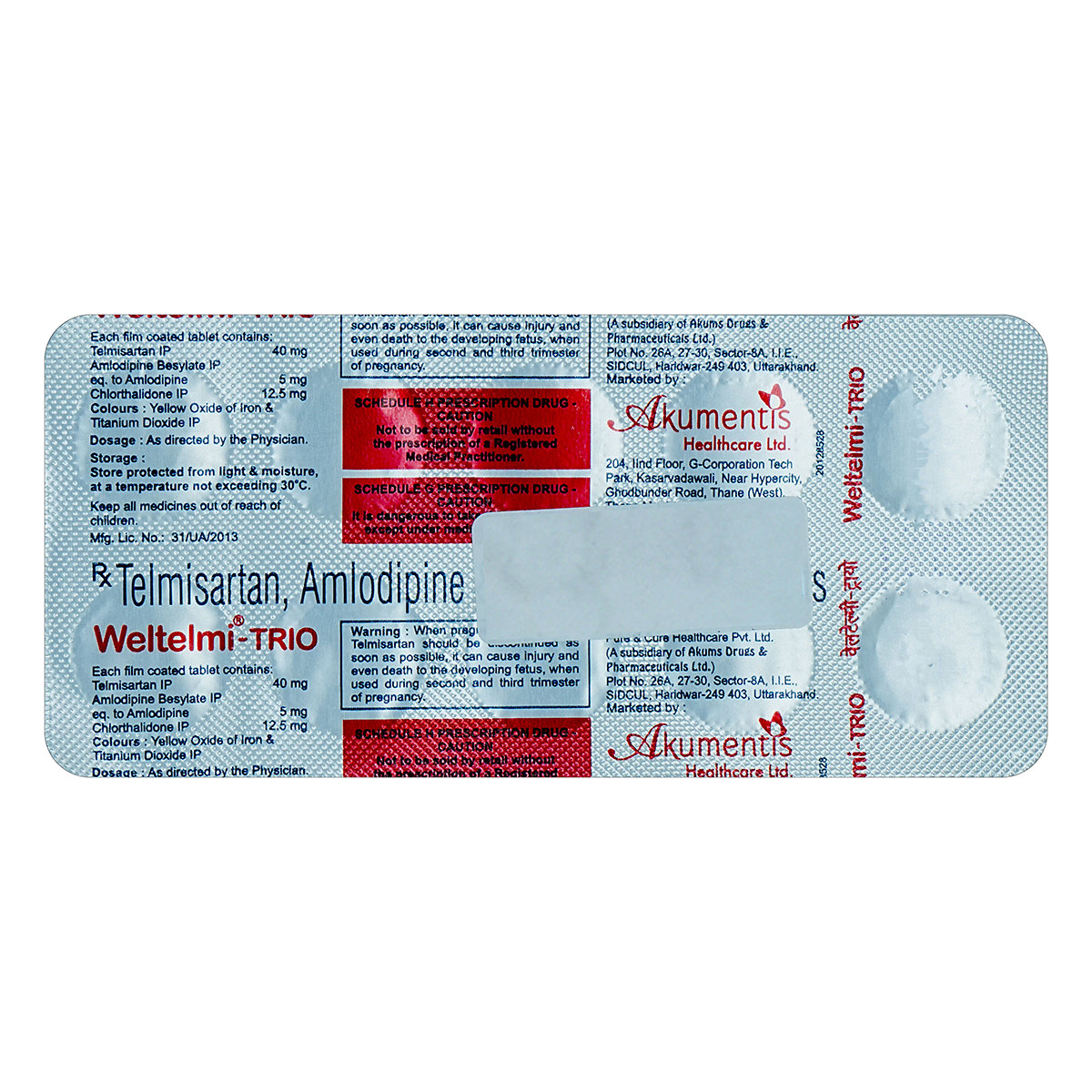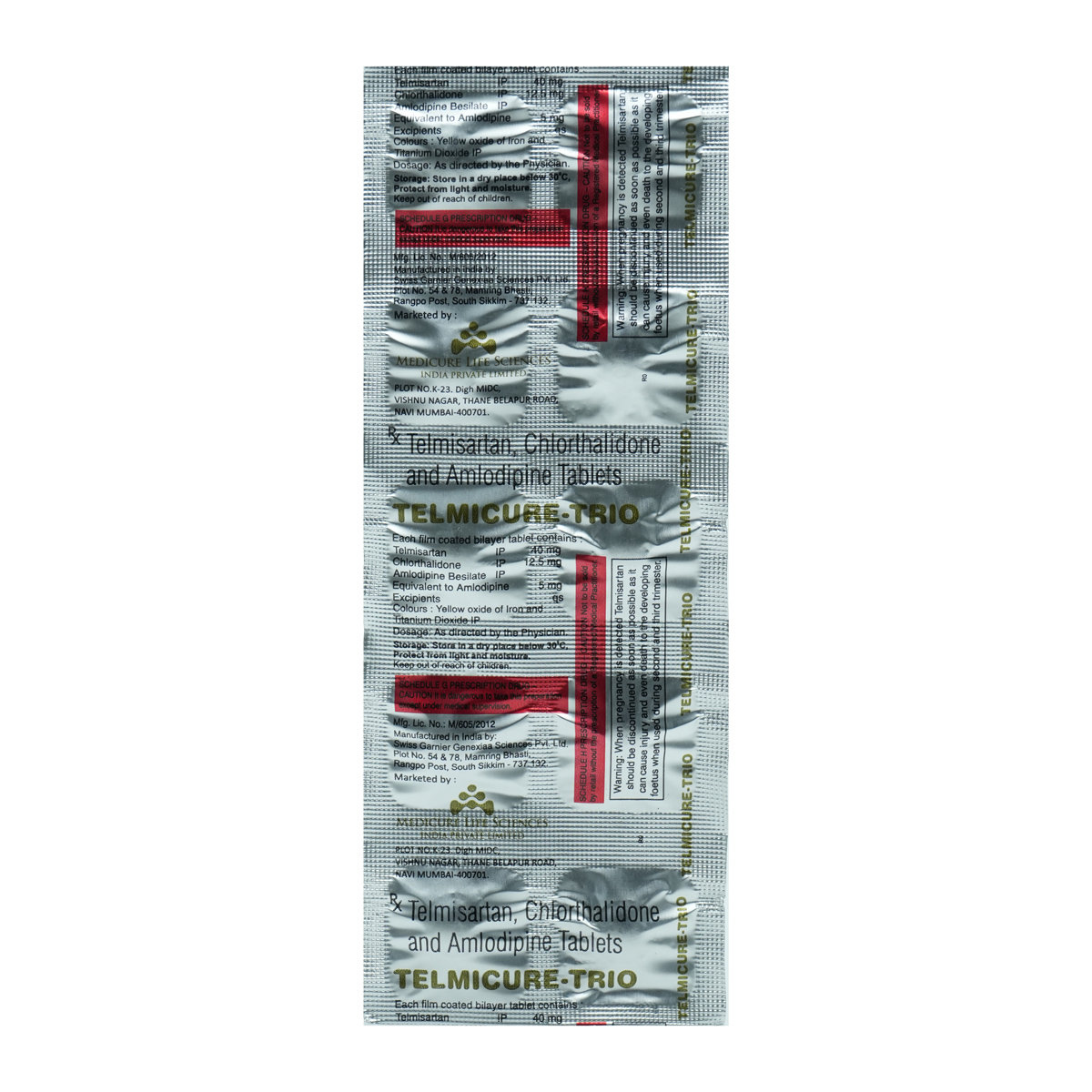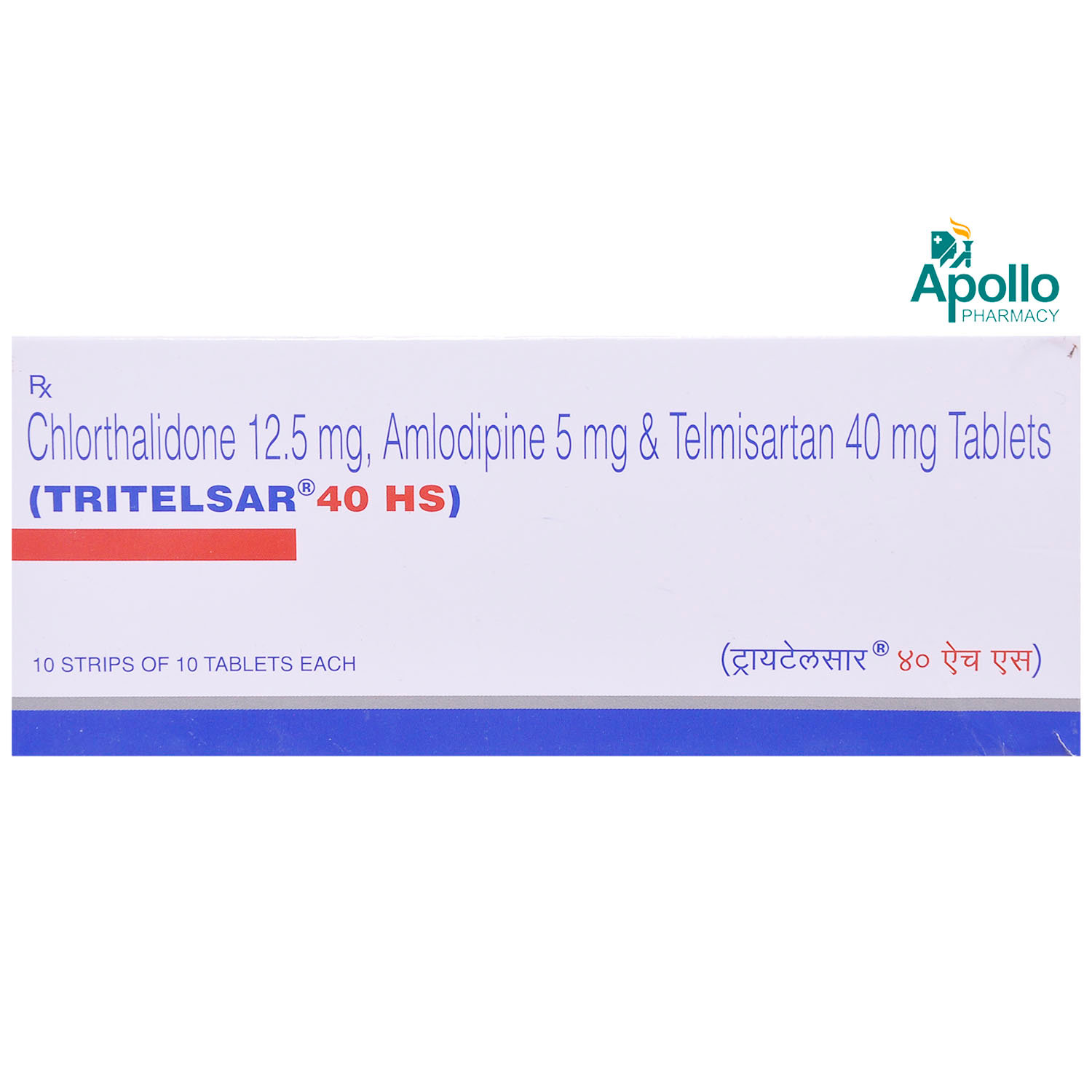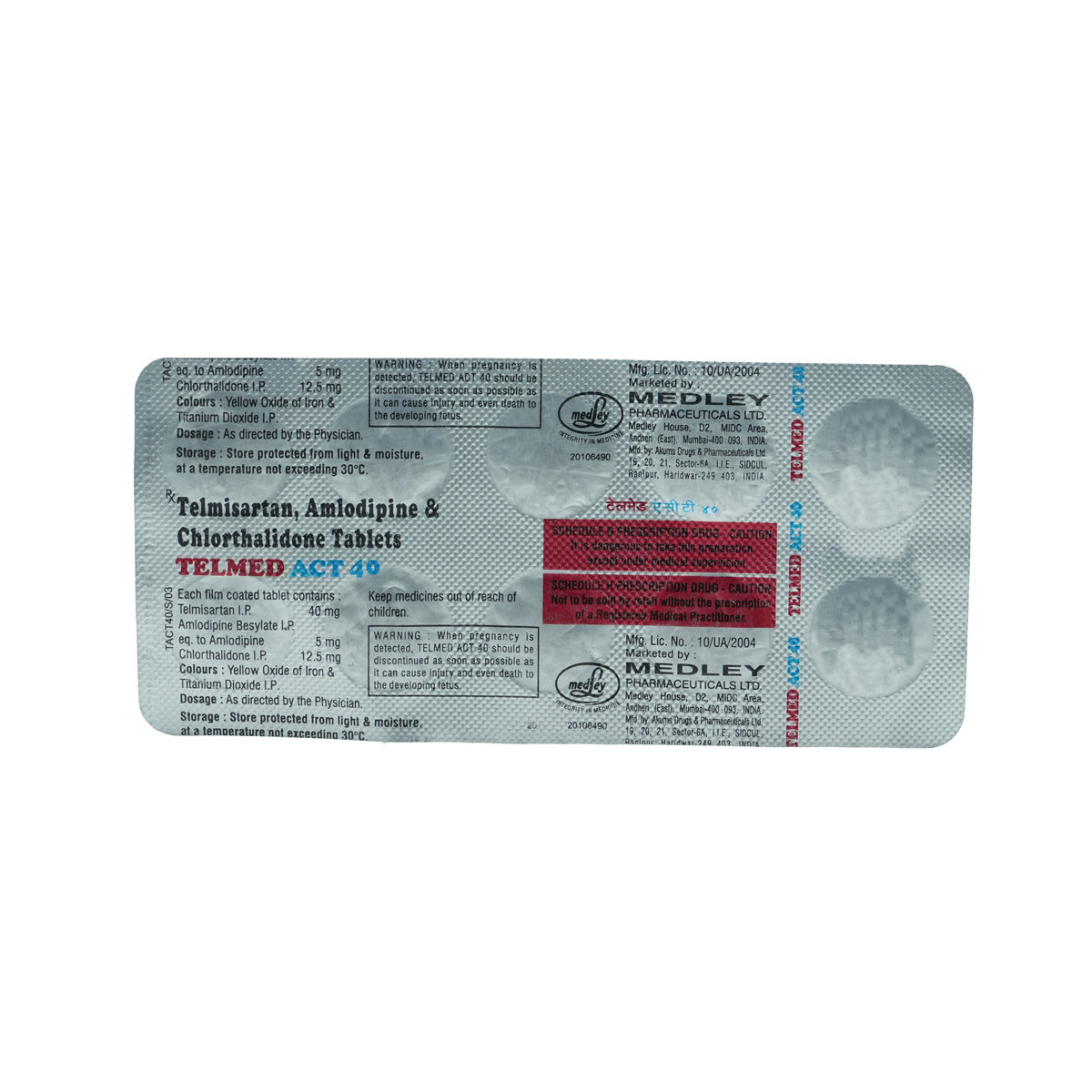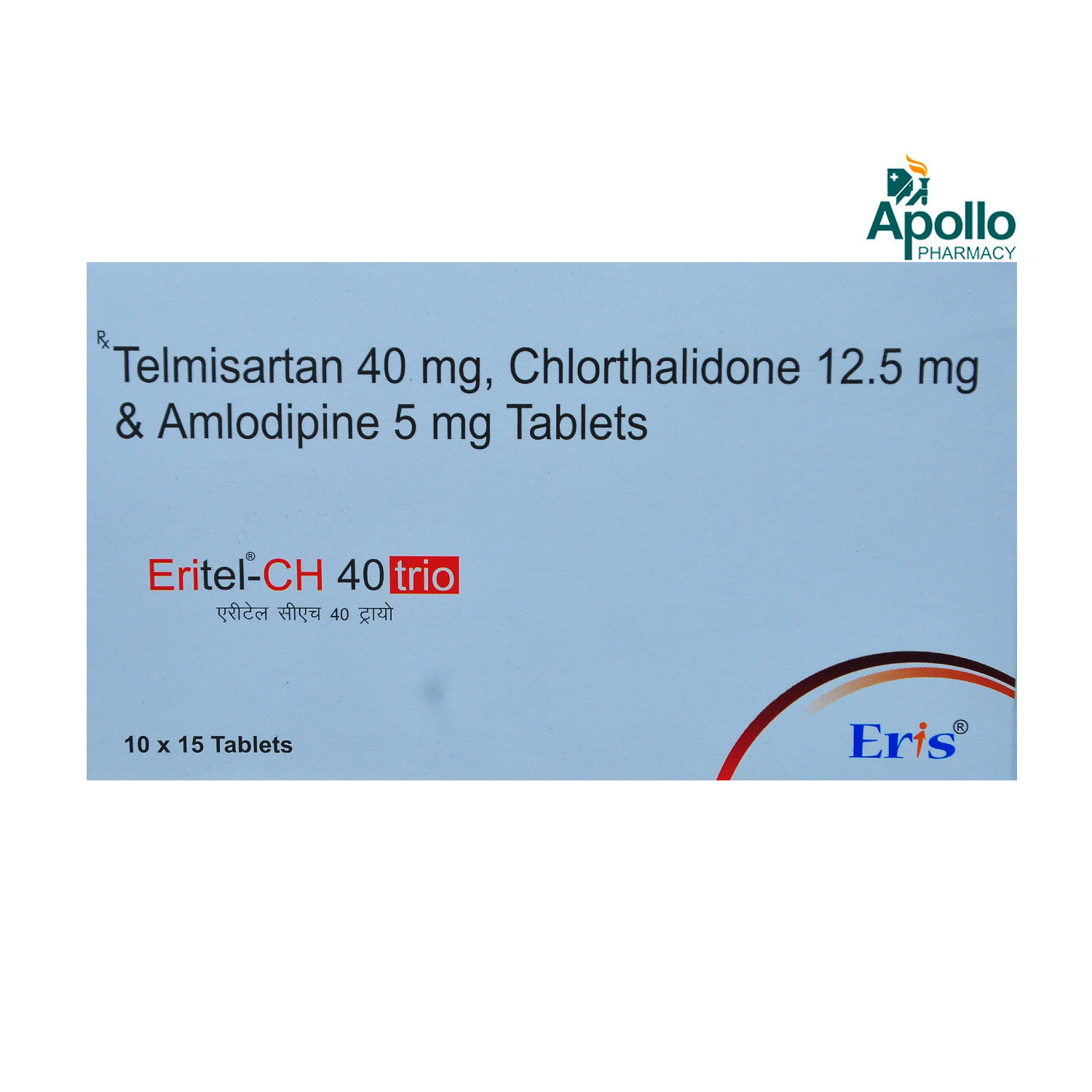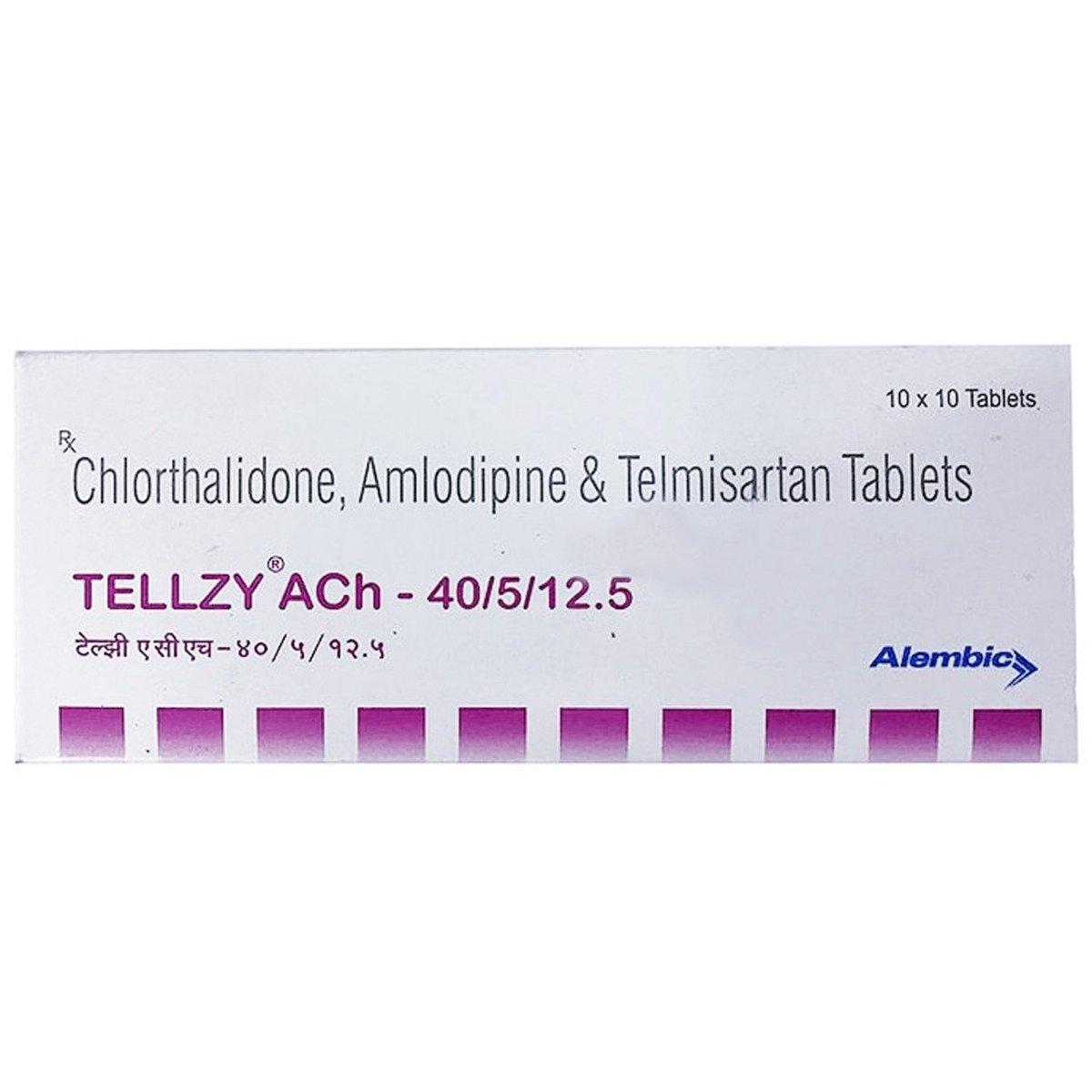CTD-T AM 12.5/40/5 Table 10's
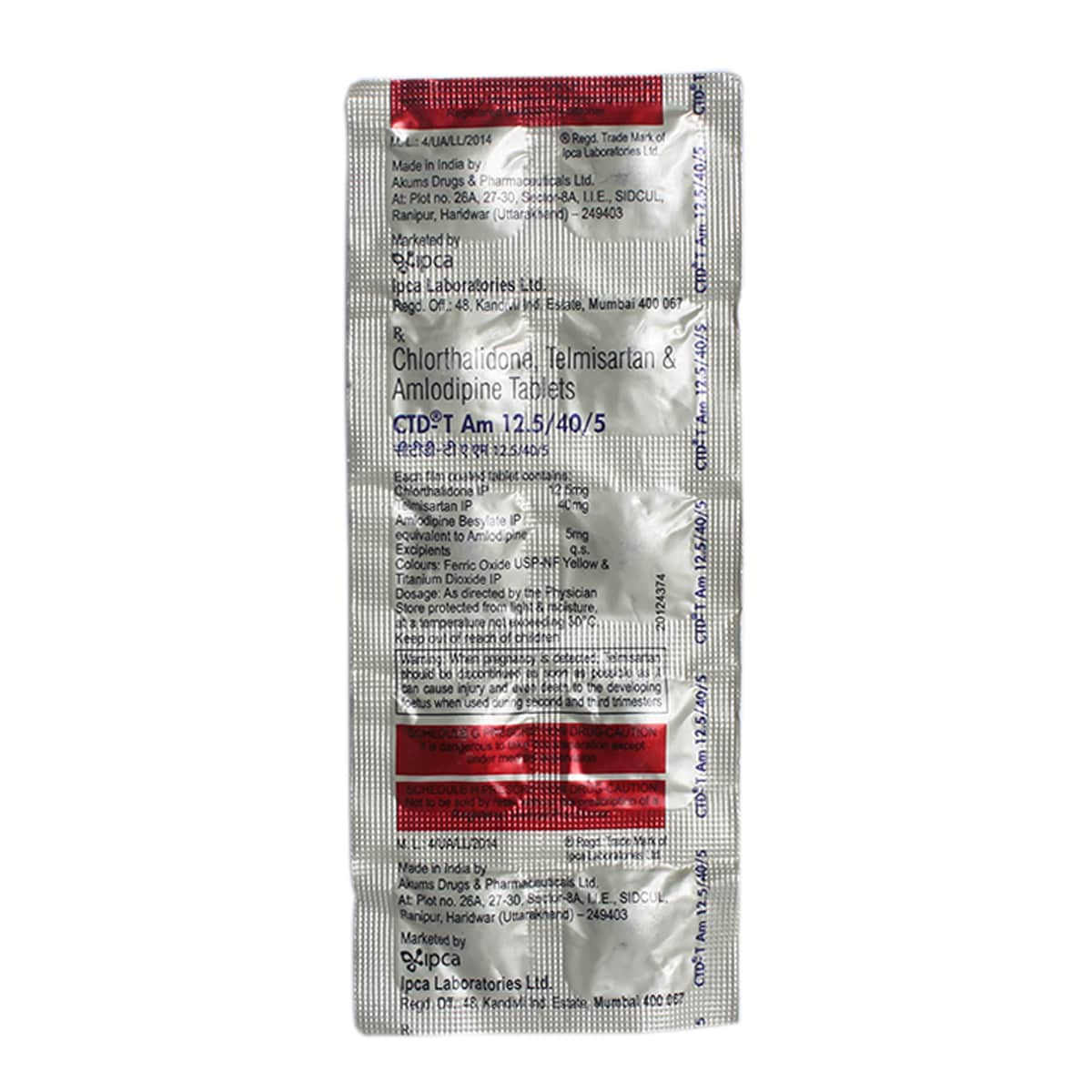
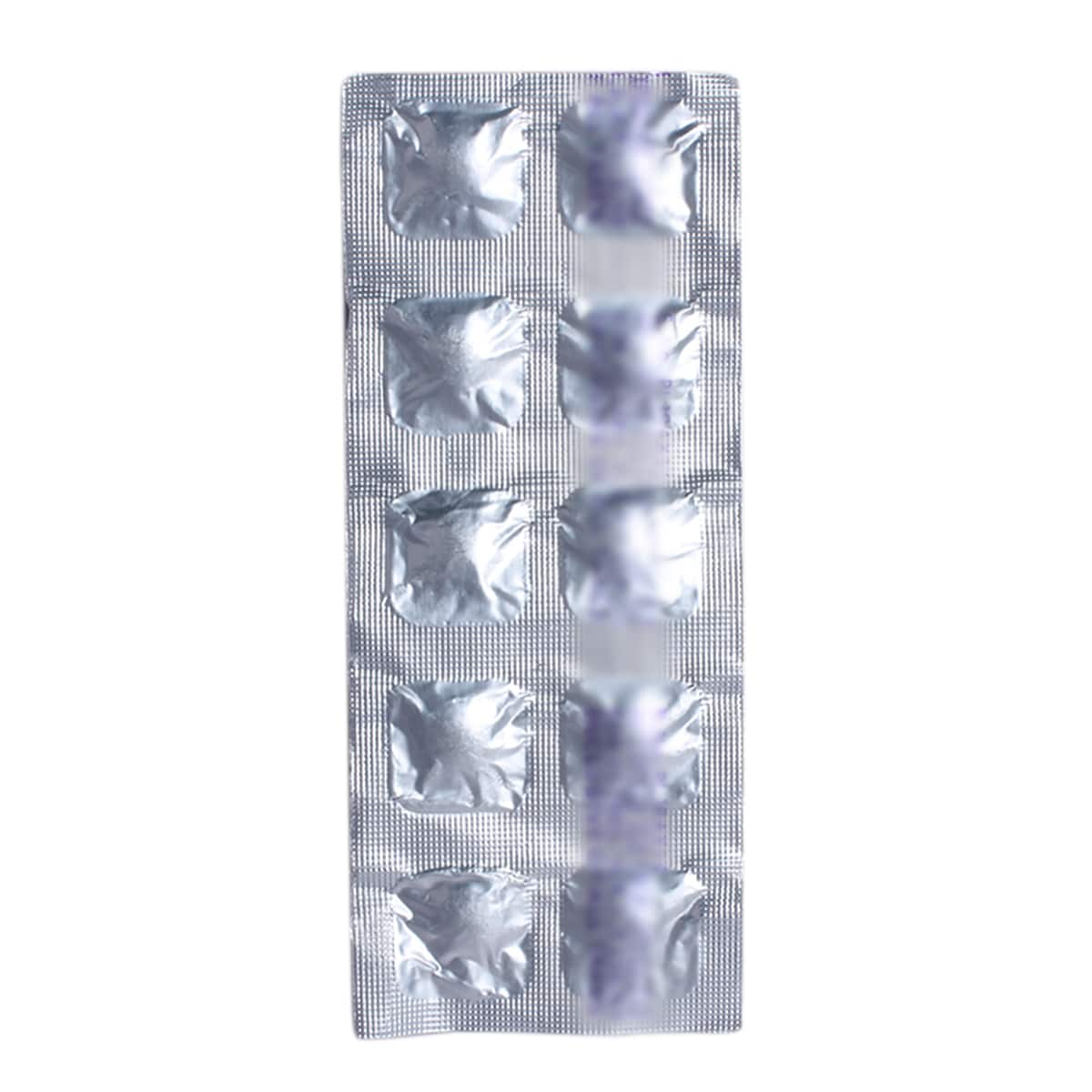


MRP ₹157.5
(Inclusive of all Taxes)
₹23.6 Cashback (15%)
Provide Delivery Location
Online payment accepted
 Prescription drug
Prescription drugWhats That
Manufacturer/Marketer :
Consume Type :
Expires on or after :
Return Policy :
About CTD-T AM 12.5/40/5 Table
CTD-T AM 12.5/40/5 Table belongs to the anti-hypertensive drugs class, primarily used to treat high blood pressure (hypertension). Hypertension is a medical condition in which blood pressure is elevated persistently in the arteries. It is considered an essential risk factor for cardiovascular diseases.
CTD-T AM 12.5/40/5 Table consists of three anti-hypertensive medicines, namely: Amlodipine, Chlorthalidone, and Telmisartan. Amlodipine belongs to the class of calcium channel blockers. It is a vasodilator that dilates (widens) blood vessels and increases blood flow, further improving the oxygen delivery to the heart tissue. Chlorthalidone belongs to the class of diuretics (water pill) with antihypertensive activity. It inhibits sodium and chloride reabsorption from absorbing excess salts that cause fluid retention or build-up. Chlorthalidone lowers blood pressure by decreasing the amount of blood the heart pumps (cardiac output) and reducing plasma and extracellular fluid volume (body fluids outside the cells). Telmisartan belongs to a group of drugs called angiotensin II receptor antagonists (angiotensin is a hormone that constricts blood vessels and increases blood pressure). It lowers blood pressure and increases blood flow by preventing the narrowing of blood vessels.
In some cases, CTD-T AM 12.5/40/5 Table can cause side effects like sleepiness, taste changes, ankle swelling, headache, flushing (feeling warmth in the face, ears, neck, and trunk), dizziness, tiredness, palpitations (irregular heartbeat), and upset stomach. Most of these side effects of CTD-T AM 12.5/40/5 Table do not require medical attention and gradually resolve over time. However, if these side effects persist longer, please consult your doctor.
If you are known to be allergic to CTD-T AM 12.5/40/5 Table or any other medicines, please inform your doctor. Before taking CTD-T AM 12.5/40/5 Table , let your doctor know if you have any heart, kidney, or liver problems, diabetes, electrolyte imbalance, and dehydration. Avoid potassium supplements with CTD-T AM 12.5/40/5 Table as it may lead to high potassium levels in the blood. Pregnant or breastfeeding women should also consult their doctor before taking CTD-T AM 12.5/40/5 Table . It is advised to complete the prescribed course, even if you feel better. Please do not stop taking CTD-T AM 12.5/40/5 Table on your own, as it may lead to the recurrence of symptoms or worsen the disease. Do not consume alcohol with CTD-T AM 12.5/40/5 Table as it may increase the risk of low blood pressure.
Uses of CTD-T AM 12.5/40/5 Table
Directions for Use
Key Benefits
CTD-T AM 12.5/40/5 Table is an anti-hypertensive drug that treats high blood pressure (hypertension). It contains Amlodipine, Chlorthalidone, and Telmisartan. Amlodipine is a calcium channel blocker that dilates (widens) blood vessels and increases blood flow. It is used to treat high blood pressure, chest pain (angina), and other conditions caused by coronary artery disease. Chlorthalidone is a diuretic (water pill). It prevents the body from absorbing excess salts that cause fluid retention or build-up. It effectively treats high blood pressure, fluid retention in patients with congestive heart failure, cirrhosis (chronic damage) of the liver, kidney disorders, or edema caused by steroids or estrogen therapy. Telmisartan is an angiotensin II receptor antagonist (angiotensin is a hormone that constricts blood vessels and increases blood pressure). It lowers blood pressure and increases blood flow by preventing the narrowing of blood vessels. It reduces the risk of stroke, heart attack, or death from heart problems.
Storage
- Eat smaller meals and chew food thoroughly.
- Try foods with softer textures.
- If you have difficulty swallowing liquids, use thickener.
- Learn new swallowing techniques from a speech and language therapist.
- Avoid alcohol and caffeine as these may dry your throat and mouth making it more difficult to swallow.
- Consider alternative forms of feeding, such as feeding tubes through nose or a hole into your stomach.
- Talk to your doctor about oral potassium supplements.
- Eat potassium rich foods such as bananas, avocados, oranges, dark leafy greens, beans and peas, fish, spinach, milk and tomatoes.
- Limit intake of full-fat dairy products, red meat and processed foods rich in saturated fats.
- Avoid foods with label “partially hydrogenated oils”.
- Eat more vegetables, fruits, oats, whole grains, lentils and beans to increase fiber intake.
- Include foods rich in monounsaturated fats like nuts, avocados, olive oil, and oily fish.
- Limit consumption of egg yolks.
- Exercise for at least 30 minutes 5 days a week.
- Aim for weight loss and maintain healthy weight.
- Quit smoking as smoking raises the risk of heart disease associated with cholesterol.
- Limit alcohol consumption as excessive drinking may raise cholesterol levels.
- Inform Your Doctor: Notify your doctor immediately about your diarrhoea symptoms. This allows them to adjust your medication or provide guidance on managing side effects.
- Stay Hydrated: Drink plenty of fluids to replace lost water and electrolytes. Choose water, clear broth, and electrolyte-rich drinks. Avoid carbonated or caffeinated beverages to effectively rehydrate your body.
- Follow a Bland Diet: Eat easy-to-digest foods to help firm up your stool and settle your stomach. Try incorporating bananas, rice, applesauce, toast, plain crackers, and boiled vegetables into your diet.
- Avoid Trigger Foods: Steer clear of foods that can worsen diarrhoea, such as spicy, fatty, or greasy foods, high-fibre foods, and dairy products (especially if you're lactose intolerant).
- Practice Good Hygiene: Maintain good hygiene to prevent the spread of infection. To stay healthy, wash your hands frequently, clean and disinfect surfaces regularly, and avoid exchanging personal belongings with others.
- Take Anti-Diarrheal Medications: If your doctor advises, anti-diarrheal medications such as loperamide might help manage diarrhoea symptoms. Always follow your doctor's directions.
- Keep track of your diarrhoea symptoms. If they don't get better or worse or are accompanied by severe stomach pain, blood, or dehydration signs (like extreme thirst or dark urine), seek medical help.
- Drink water or other clear fluids.
- To prevent worsening of pain, limit intake of tea, coffee, or alcohol.
- Include bland foods like rice, toast, crackers, and rice in your diet.
- Avoid lying down immediately after eating as it may cause indigestion or heartburn.
- Avoid acidic and spicy food as it may cause indigestion.
- Avoid triggers like alcohol, caffeine, and energy drinks.
- Try relaxation techniques such as yoga, meditation, or deep breathing.
- Exercise regularly as it helps maintain heart health.
- Follow a nutritious and balanced diet.
Drug Warnings
Monitor your blood pressure levels regularly. If you are known to be allergic to CTD-T AM 12.5/40/5 Table or have any kidney or liver problems or severe dehydration, please inform your doctor beforehand. Brief your medical history if you have low blood pressure, diabetes, gout, lupus (immune system disorder), hyperkalemia (high potassium levels), heart diseases (aortic stenosis, heart failure), angioedema (swelling of the lower layer of skin and tissue), anuria (low or no urine output), and asthma before starting CTD-T AM 12.5/40/5 Table . Avoid potassium supplements with CTD-T AM 12.5/40/5 Table as it may lead to high potassium levels in the blood. Too much sweating, diarrhea, or vomiting while using CTD-T AM 12.5/40/5 Table may lead to dehydration; hence it is advised to drink enough fluids. CTD-T AM 12.5/40/5 Table can affect and harm the developing baby during pregnancy. Consult your doctor before using CTD-T AM 12.5/40/5 Table if you are a pregnant or breastfeeding mother. Complete the course strictly as suggested by the doctor, even if you feel better, to avoid disease recurrence. Avoid consumption of alcohol with CTD-T AM 12.5/40/5 Table as it may increase the risk of low blood pressure. Safety and effectiveness of CTD-T AM 12.5/40/5 Table in pediatric patients have not been established.
Drug-Drug Interactions
Drug-Drug Interactions
Login/Sign Up
Using CTD-T AM 12.5/40/5 Table together with dantrolene may increase the risk of hyperkalemia (high blood potassium).
How to manage the interaction:
Taking CTD-T AM 12.5/40/5 Table with Dantrolene can cause an interaction, consult a doctor before taking it. You should seek medical attention if you experience nausea, vomiting, weakness, confusion, tingling of the hands and feet, a weak pulse, or a slow or irregular heartbeat. Do not stop using any medications without talking to a doctor.
Co-administration of Aliskiren with CTD-T AM 12.5/40/5 Table can increase the risk of hyperkalemia (high potassium levels in the blood).
How to manage the interaction:
Taking CTD-T AM 12.5/40/5 Table with Aliskiren can possibly lead to an interaction, please consult a doctor before taking it. Do not discontinue the medications without consulting a doctor.
Co-administration of CTD-T AM 12.5/40/5 Table and cisapride may increase the risk or severity of an irregular heart rhythm that may be serious.
How to manage the interaction:
Taking CTD-T AM 12.5/40/5 Table with Cisapride is not recommended, please consult your doctor before taking it. Do not discontinue the medication without consulting a doctor.
Using CTD-T AM 12.5/40/5 Table and mitotane together may drastically lower CTD-T AM 12.5/40/5 Table blood levels, which makes the medicine less effective.
How to manage the interaction:
Although co-administration of CTD-T AM 12.5/40/5 Table with mitotane can result in an interaction, it can be taken if a doctor has advised it. Do not discontinue any medications without consulting a doctor.
Using phenobarbital and CTD-T AM 12.5/40/5 Table may drastically lower CTD-T AM 12.5/40/5 Table blood levels, which makes the medicine less effective.
How to manage the interaction:
Although co-administration of phenobarbital with CTD-T AM 12.5/40/5 Table can result in an interaction, it can be taken if a doctor has advised it. Do not discontinue any medications without consulting a doctor.
Coadministration of CTD-T AM 12.5/40/5 Table and carbamazepine together may significantly reduce CTD-T AM 12.5/40/5 Table blood levels, making the medicine less effective.
How to manage the interaction:
Although there is an interaction between CTD-T AM 12.5/40/5 Table with carbamazepine, it can be taken if a doctor has advised it. However, if you experience any unusual symptoms contact the doctor immediately. Do not stop using any medications without talking to a doctor.
Using CTD-T AM 12.5/40/5 Table and phenytoin together may drastically lower CTD-T AM 12.5/40/5 Table blood levels, which makes the medicine less effective.
How to manage the interaction:
Although CTD-T AM 12.5/40/5 Table with phenytoin can result in an interaction, it can be taken if a doctor has advised it. Do not discontinue any medications without consulting a doctor.
Using CTD-T AM 12.5/40/5 Table and primidone together may lower CTD-T AM 12.5/40/5 Table blood levels, which makes the medicine less effective.
How to manage the interaction:
Although co-administration of CTD-T AM 12.5/40/5 Table with primidone can result in an interaction, it can be taken if a doctor has advised it. Do not discontinue any medications without consulting a doctor.
Coadministration of lemborexant and CTD-T AM 12.5/40/5 Table may increase the blood levels of lemborexant.
How to manage the interaction:
Although co-administration of CTD-T AM 12.5/40/5 Table with Lemborexant can result in an interaction, it can be taken if a doctor has advised it. However, consult your doctor if you experience abnormal sleep patterns, worsening of depression, changes in heartbeat, or headache. Do not discontinue any medications without consulting a doctor.
Taking simvastatin with CTD-T AM 12.5/40/5 Table may result in considerably higher blood levels of simvastatin and may increase the risk of side effects (liver damage and rhabdomyolysis - an uncommon but serious illness characterized by the breakdown of skeletal muscle tissue).
How to manage the interaction:
Although taking CTD-T AM 12.5/40/5 Table with simvastatin can result in an interaction, it can be taken if a doctor has advised it. If you have unexplained muscular pain, soreness, or weakness while using simvastatin, especially if these symptoms are accompanied by fever or dark-colored urine, consult the doctor immediately. However, if you develop a fever, chills, joint pain or swelling, unusual bleeding or bruising, skin rash, itching, loss of appetite, fatigue, nausea, vomiting, dark colored urine, and/or yellowing of the skin or eyes, consult the doctor. Do not stop using any medications without a doctor's advice.
Drug-Food Interactions
Drug-Food Interactions
Login/Sign Up
Lentils, Orange Juice, Oranges, Raisins, Potatoes, Salmon Dried, Spinach, Tomatoes, Sweet Potatoes, Coconut Water, Beans, Beetroot, Broccoli, Bananas, Apricots, Avocado, Yogurt
How to manage the interaction:
Taking potassium rich food while on the treatment with Amlodipine, chlorthalidone and telmisartan can increase the levels of potassium salt in blood which lead to experience nausea, vomiting, weakness, confusion, tingling in hands or feet, feeling of heaviness in the legs, or slow or rapid heartbeat. Avoid or limit taking potassium rich food while on the treatment with Amlodipine, chlorthalidone and telmisartan.
Diet & Lifestyle Advise
- Reduce sodium intake in your diet to maintain your blood pressure.
- Eat natural and healthy foods by cutting down on high on sodium processed foods.
- Lose those extra pounds since being obese can be a risk factor for hypertension.
- Exercise regularly to maintain good heart health.
- Avoid smoking and alcohol intake.
- Chronic stress may also cause high blood pressure. Therefore, avoid stress triggers and make time for yourself to relax and do activities that you enjoy.
- Try to include heart-healthy omega-3 fatty acids-containing food drinks in your daily diet. You can also use low-fat cooking oil like olive oil, soybean oil, canola oil, and coconut oil to lower your elevated blood pressure.
- Limit sodium chloride intake (table salt) in your daily diet to 2300 mg per day or less than 1500 mg is ideal for most adults.
Side Effects of CTD-T AM 12.5/40/5 Table
- Sleepiness
- Taste changes
- Ankle swelling
- Headache
- Flushing (feeling warmth in the face, ears, neck, and trunk)
- Dizziness
- Tiredness
- Palpitations (irregular heartbeat)
- Altered blood glucose levels
- Upset stomach
Habit Forming
Therapeutic Class
All Substitutes & Brand Comparisons
RX
Aztel Trio 12.5 Tablet 15's
Azkka Pharmaceuticals Pvt Ltd
₹120.5
(₹7.23 per unit)
49% CHEAPERRX
Weltelmi-Trio Tablet 10's
Akumentis Healthcare Ltd
₹91.5
(₹8.24 per unit)
41% CHEAPERRX
Out of StockTelista Trio 40 mg Tablet 10's
Lupin Ltd
₹93.5
(₹8.42 per unit)
40% CHEAPER
Product Substitutes
Author Details
We provide you with authentic, trustworthy and relevant information
Drug-Diseases Interactions
Drug-Diseases Interactions
Login/Sign Up
FAQs
CTD-T AM 12.5/40/5 Table consists of anti-hypertensive/ blood pressure-lowering drugs: Amlodipine, Chlorthalidone, and Telmisartan. These medicines collectively lower the blood pressure by preventing the fluid build-up and widening the blood vessels, thus improving the blood supply and oxygen delivery to the heart.
Yes, CTD-T AM 12.5/40/5 Table can make you feel dizzy. Dizziness usually occurs when you suddenly stand up from a lying or sitting position. Try rising slowly when you change your posture to relieve dizziness. If the side effect persists longer, please seek medical help.
CTD-T AM 12.5/40/5 Table may cause ankle swelling upon long-term use. Please try to keep your feet at elevated levels when sitting for long hours or sleeping. If the problem persists, consult your doctor and do as advised.
CTD-T AM 12.5/40/5 Table can cause high potassium levels in the blood leading to hyperkalemia (high potassium levels in the blood). Hence it is not recommended to use potassium supplements along with CTD-T AM 12.5/40/5 Table . However, consult your doctor if you are already taking other medicines before starting CTD-T AM 12.5/40/5 Table .
Do not stop using CTD-T AM 12.5/40/5 Table even if you feel better. It should be strictly used as advised by your doctor to avoid the recurrence of symptoms and worsening of the disease.
Please inform your doctor if you are taking CTD-T AM 12.5/40/5 Table and need to undergo any surgery. Your doctor may ask you to stop using CTD-T AM 12.5/40/5 Table or prescribe any alternate medication because blood pressure may be further lowered if taken along with general anesthesia.
Drug-Drug Interactions Checker List
- NEBIVOLOL
- METOPROLOL
- ALISKIREN
- RAMIPRIL
- BENAZEPRIL
- LISINOPRIL
- DULOXETINE
- INSULIN GLARGINE
- ERGOCALCIFEROL
- CHOLECALCIFEROL
- ASPIRIN
- NAPROXEN
- IBUPROFEN
- APIXABAN
- ATORVASTATIN
- PREGABALIN
- LITHIUM
- CISAPRIDE
- DOFETILIDE
- DROSPIRENONE
Special Advise
- Keep a check on your daily blood pressure, and if you notice any fluctuations, please consult a doctor.
- Your doctor may ask you to undergo blood and urine tests if you have been suffering from vomiting or dehydration.
- If you have diabetes, using CTD-T AM 12.5/40/5 Table may affect your blood sugar levels. Inform your doctor so that your diabetes medication may be adjusted accordingly.
- Your dietician may prescribe you a suitable exercise program and diet to manage your blood pressure.
- Thiazide diuretics like Chlorthalidone may increase serum triglyceride and cholesterol levels. Hence it is advised to monitor your cholesterol levels regularly.
- Therapy with CTD-T AM 12.5/40/5 Table should be discontinued if you have been suggested tests for parathyroid function in cases like hyperparathyroidism (excessive parathyroid hormone levels).
Disease/Condition Glossary
Hypertension is a medical condition in which blood pressure is elevated persistently in the arteries. It is considered an essential risk factor for cardiovascular diseases and can be caused due to obesity, diabetes, smoking, high salt intake, stress, lack of physical activity, or ageing. Blood pressure is measured in the ratio of systolic pressure to diastolic pressure. Systolic pressure is the pressure when the heart pumps blood out. On the other hand, diastolic pressure is the pressure when your heart is at the resting stage between heartbeats. If your blood pressure is 140/90 mm of Hg, it means the systolic pressure is 140 mm of Hg and, diastolic pressure is 90 mm of Hg. The ideal blood pressure range lies in between 90/60 mmHg and 120/80 mmHg. If the blood pressure is 140/90 mmHg or greater, it is considered high blood pressure.

Have a query?
Buy best Cardiology products by
Torrent Pharmaceuticals Ltd
Sun Pharmaceutical Industries Ltd
Lupin Ltd
Intas Pharmaceuticals Ltd
Cipla Ltd
Micro Labs Ltd
Macleods Pharmaceuticals Ltd
Abbott India Ltd
Ajanta Pharma Ltd
Ipca Laboratories Ltd
Eris Life Sciences Ltd
Mankind Pharma Pvt Ltd
Lloyd Healthcare Pvt Ltd
Dr Reddy's Laboratories Ltd
Glenmark Pharmaceuticals Ltd
Emcure Pharmaceuticals Ltd
Alembic Pharmaceuticals Ltd
Alkem Laboratories Ltd
East West Pharma India Pvt Ltd
USV Pvt Ltd
Zydus Healthcare Ltd
Aristo Pharmaceuticals Pvt Ltd
Elbrit Life Sciences Pvt Ltd
J B Chemicals & Pharmaceuticals Ltd
Zydus Cadila
Akumentis Healthcare Ltd
Alteus Biogenics Pvt Ltd
Hbc Life Sciences Pvt Ltd
Fusion Health Care Pvt Ltd
Troikaa Pharmaceuticals Ltd
La Renon Healthcare Pvt Ltd
Corona Remedies Pvt Ltd
Jubilant Lifesciences Ltd
Medley Pharmaceuticals Ltd
Knoll Healthcare Pvt Ltd
Msn Laboratories Pvt Ltd
Zuventus Healthcare Ltd
Cadila Pharmaceuticals Ltd
Blue Cross Laboratories Pvt Ltd
Lividus Pharmaceuticals Pvt Ltd
Morepen Laboratories Ltd
Ranmarc Labs
Shrrishti Health Care Products Pvt Ltd
Sanofi India Ltd
Steris Healthcare
Elder Pharmaceuticals Ltd
Primus Remedies Pvt Ltd
Unison Pharmaceuticals Pvt Ltd
Eswar Therapeutics Pvt Ltd
Knoll Pharmaceuticals Ltd
Tas Med India Pvt Ltd
Systopic Laboratories Pvt Ltd
Indiabulls Pharmaceuticals Pvt Ltd
Leeford Healthcare Ltd
Sinsan Pharmaceuticals Pvt Ltd
Biochem Pharmaceutical Industries Ltd
Cadila Healthcare Ltd
Azkka Pharmaceuticals Pvt Ltd
Nirvana India Pvt Ltd
Orsim Pharma
Prevego Healthcare & Research Pvt Ltd
Econ Healthcare
Elinor Pharmaceuticals (P) Ltd
FDC Ltd
Sunij Pharma Pvt Ltd
Nicholas Piramal India Ltd
Astra Zeneca Pharma India Ltd
Pfizer Ltd
Lia Life Sciences Pvt Ltd
Shine Pharmaceuticals Ltd
Elicad Pharmaceuticals Pvt Ltd
Indoco Remedies Ltd
Proqol Health Care Pvt Ltd
Vasu Organics Pvt Ltd
Biocon Ltd
Opsis Care Lifesciences Pvt Ltd
Johnlee Pharmaceuticals Pvt Ltd
Merck Ltd
Wockhardt Ltd
Auspharma Pvt Ltd
Ergos Life Sciences Pvt Ltd
Lakshya Life Sciences Pvt Ltd
Ordain Health Care Global Pvt Ltd
Pficus De Med Pvt Ltd
ALICAN PHARMACEUTICAL PVT LTD
RPG Life Sciences Ltd
Glynis Pharmaceuticals Pvt Ltd
Orris Pharmaceuticals
Samarth Life Sciences Pvt Ltd
Aprica Pharmaceuticals Pvt Ltd
Aretaeus Pharmaceuticals Pvt Ltd
Koye Pharmaceuticals Pvt Ltd
Neocardiab Care
Retra Life Science Pvt Ltd
Alniche Life Sciences Pvt Ltd
Alvio Pharmaceuticals Pvt Ltd
Arkas Pharma Pvt Ltd
Atos Lifesciences Pvt Ltd
Divine Savior Pvt Ltd
Metalis Lifesciences Pvt Ltd
Alcohol
Safe if prescribed
It is unsafe to consume alcohol since alcohol consumption with CTD-T AM 12.5/40/5 Table may increase the risk of low blood pressure and cause adverse effects, such as dizziness, fainting, light-headedness, or headache.
Pregnancy
Consult your doctor
CTD-T AM 12.5/40/5 Table is not recommended and unsafe in pregnancy. It can affect and harm the developing baby. Consult your doctor before taking CTD-T AM 12.5/40/5 Table if you plan to become pregnant or already pregnant. Your doctor will weigh the potential risks and benefits before prescribing CTD-T AM 12.5/40/5 Table .
Breast Feeding
Consult your doctor
There is no evidence on how CTD-T AM 12.5/40/5 Table affects breastfeeding. Please consult your doctor before taking CTD-T AM 12.5/40/5 Table if you are breastfeeding.
Driving
Safe if prescribed
CTD-T AM 12.5/40/5 Table may cause side effects like dizziness, headaches, nausea, or tiredness, which can affect your ability to concentrate and drive. Hence, it is recommended not to drive or operate machinery until you are mentally alert.
Liver
Consult your doctor
Let your doctor know if you have any history of liver diseases before taking CTD-T AM 12.5/40/5 Table . The dosage will be initiated in lower doses and will be further increased in patients with liver diseases. However, CTD-T AM 12.5/40/5 Table is not recommended in patients with severe hepatic impairment.
Kidney
Consult your doctor
CTD-T AM 12.5/40/5 Table may affect kidney functioning. Hence it is advised to seek doctor advice before starting CTD-T AM 12.5/40/5 Table if you have kidney problems. However, it is not recommended in patients with severe renal impairment.
Children
Safe if prescribed
Safety and effectiveness of CTD-T AM 12.5/40/5 Table in pediatric patients have not been established.
Recommended for a 30-day course: 3 Strips



